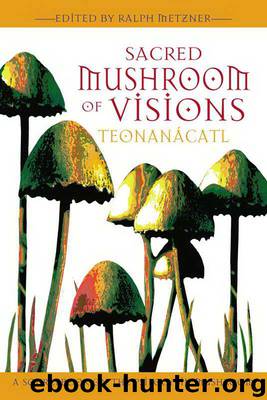Sacred Mushroom of Visions: Teonanácatl: A Sourcebook on the Psilocybin Mushroom by Ralph Metzner Ph.D

Author:Ralph Metzner Ph.D. [Metzner Ph.D., Ralph]
Language: eng
Format: epub
Publisher: Inner Traditions/Bear & Company
Published: 2005-07-25T04:00:00+00:00
to raise awareness in a new generation of students and researchers about what this author believed at the beginning of this follow-up was a successfully proven approach to behavior change. It was also hoped that this follow-up might help to catalyze additional research extending and expanding on Leary’s pioneering study and its reportedly promising results (Doblin 1998).
He was able to locate records for twenty-one of the original thirty-two subjects and interviewed two of them as well as three of the researchers. The criminal histories he located recorded activity for the 2.5 years following release from the incarceration in which the inmates participated in the psilocybin project, as well as up to thirty-four years later when the follow-up study was conducted. The figures closely approximated those given by Leary et al., so Doblin assumed that the lost folders were likely a random subset of the entire cohort.
Though he found some minor irregularities in Leary’s group’s reporting of recidivism rates among several papers published over several years, he found two big problems. The first was that the reported researchers had compared recidivism rates of study inmates who had been released for an average of ten months, with the recidivism rate of all Concord prison inmates who had been released for an average of thirty months. As the probability of recidivism is a function of how long someone has been out, rising over time, the comparison was invalid. Using a graph indicating the recidivism rate as a function of time, Doblin determined that the control rate was 34.3%, compared to the experimental group’s 32%, a 2.3% reduction (not the 23% reported), which is not significant and is the same as a finding of no treatment effect.
The other flaw Doblin detected was in the assertion that parole violations were of a lesser gravity than new crimes, thus that the program actually reduced the crime rate overall. Leary reported that only two prisoners were returned for new crimes and fourteen for parole violations of a minor technical nature, which were found possibly due to extra supervision the subjects received, as they were known to have taken part in this experiment. Doblin’s research revealed that many of the subjects who were returned to prison on parole violations had actually violated their parole by committing new crimes for which they were subsequently convicted. In addition, some subjects who had simple parole violations not associated with a new crime were released and subsequently rearrested for new crimes all within the follow-up period of 2.5 years.
Through comparing the findings of the follow-up with Leary’s reported results, it was possible, with some difficulty, to discern Leary’s method of categorization between new crimes and parole violations. Leary’s method counted only the reason for the first reincarceration postrelease, ignoring everything occurring after that. Thus, the distinction between parole violations and new crimes is largely meaningless, since the majority of what Leary considered “parole violations” were caused by incidents that later led to convictions for new crimes.
If “parole violation” is defined as “return
Download
This site does not store any files on its server. We only index and link to content provided by other sites. Please contact the content providers to delete copyright contents if any and email us, we'll remove relevant links or contents immediately.
| Coloring Books for Grown-Ups | Humor |
| Movies | Performing Arts |
| Pop Culture | Puzzles & Games |
| Radio | Sheet Music & Scores |
| Television | Trivia & Fun Facts |
The Social Psychology of Inequality by Unknown(2939)
Make Comics Like the Pros by Greg Pak(2852)
Stacked Decks by The Rotenberg Collection(2811)
Purple Hibiscus by Chimamanda Ngozi Adichie(2650)
The Queen of Nothing by Holly Black(2492)
The Art of Doom by Bethesda(2106)
Life of Elizabeth I by Alison Weir(2026)
Putin's Labyrinth(1960)
The Power of Habit: Why We Do What We Do in Life and Business by Charles Duhigg(1940)
Drawing Down the Moon by Margot Adler(1824)
Things Are What You Make of Them: Life Advice for Creatives by Adam J. Kurtz(1817)
Wall and Piece by Banksy(1781)
Agency by William Gibson(1778)
Art Of Atari by Tim Lapetino(1750)
Teaching to Transgress: Education as the Practice of Freedom (Harvest in Translation) by Bell Hooks(1694)
The Beatles Lyrics by Hunter Davies(1672)
The Pin-Up Art of Bill Ward by Bill Ward(1651)
Only What's Necessary: Charles M. Schulz and the Art of Peanuts by Chip Kidd(1645)
The Andy Warhol Diaries by Andy Warhol(1561)
